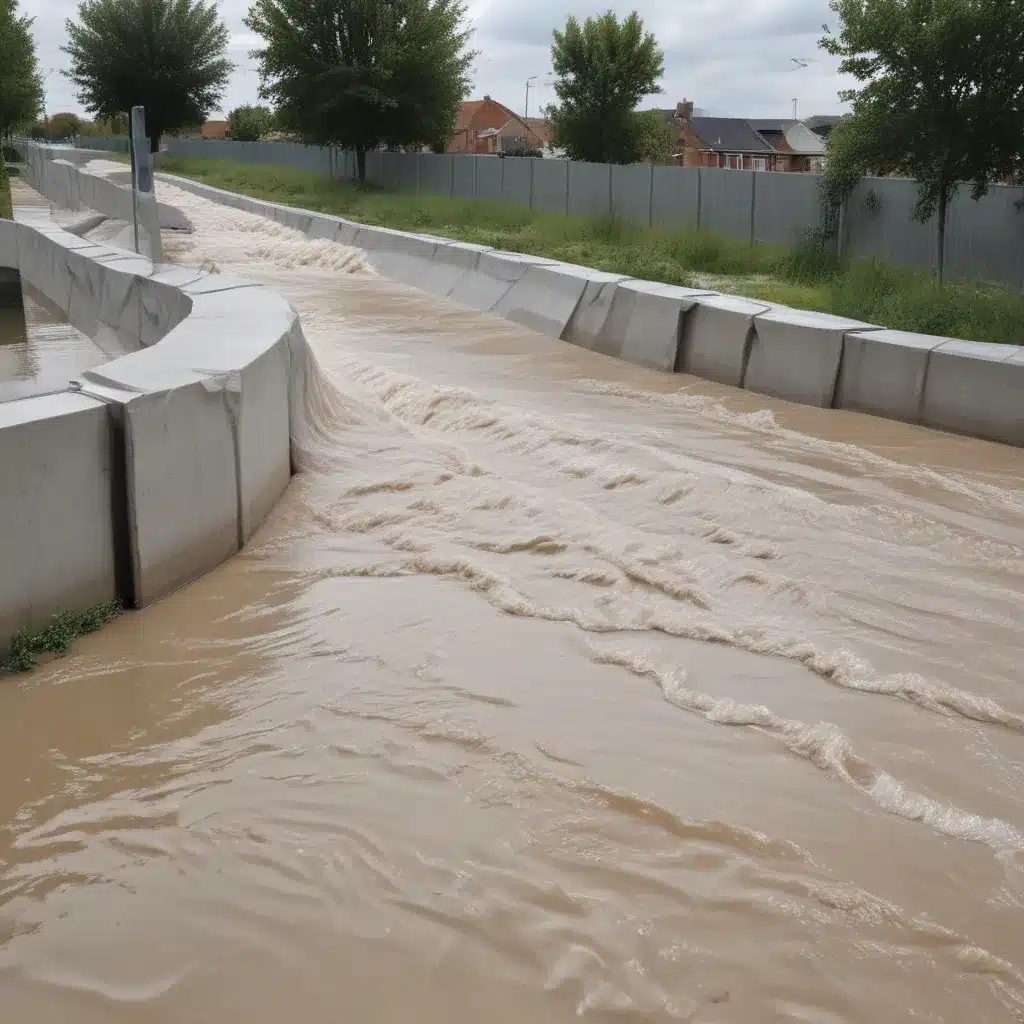
Innovative Flood Barrier Materials: Enhancing Environmental Compatibility and Circularity
As an experienced flood control specialist, I’ve seen firsthand how the design and implementation of flood control systems can have a significant impact on the surrounding environment. Traditional flood barriers like concrete levees or steel floodwalls, while effective in preventing water intrusion, often come with a heavy environmental footprint due to their energy-intensive manufacturing processes and potential disruption to local ecosystems.
However, the tide is turning as a new generation of innovative flood barrier materials emerges, promising enhanced environmental compatibility and circularity. These cutting-edge solutions draw inspiration from the principles of the circular economy – a systemic approach that aims to gradually decouple economic growth from the consumption of finite resources. By embracing renewable, recyclable, and biodegradable materials, flood control professionals can now develop flood control systems that not only protect communities but also safeguard the natural environment.
Biomimetic and Nature-Based Flood Control Solutions
One of the most promising avenues for environmentally-friendly flood barriers is the exploration of biomimetic and nature-based designs. These approaches seek to emulate the strategies and mechanisms found in nature, leveraging the inherent resilience and adaptability of natural systems.
For example, some flood barrier designs take inspiration from the self-healing properties of certain plant species or the water-repellent surfaces of lotus leaves. By incorporating these bioinspired features, flood barriers can achieve enhanced durability, self-cleaning capabilities, and reduced maintenance requirements – all while minimizing their environmental impact.
Similarly, living shorelines and constructed wetlands are gaining traction as natural flood control solutions. These systems harness the power of vegetation, sediment, and natural processes to attenuate wave energy, stabilize shorelines, and provide essential habitat for local wildlife. Not only do these nature-based approaches offer cost-effective flood protection, but they also contribute to the restoration and preservation of valuable ecosystems.
Sustainable Materials and Circular Design Principles
Beyond biomimicry, the integration of sustainable materials and circular design principles is transforming the flood control landscape. Innovative flood barrier systems are now being developed using renewable, recyclable, and biodegradable materials, such as bio-based polymers, natural fibers, and advanced composites.
These materials offer a range of environmental benefits, including:
-
Reduced Carbon Footprint: Many bio-based and recycled materials have a lower embodied carbon compared to their traditional counterparts, helping to mitigate the overall climate impact of flood control infrastructure.
-
Improved Biodegradability: Certain bioplastics and natural fiber composites can be designed to decompose safely in the environment, minimizing long-term waste accumulation.
-
Enhanced Circularity: Adopting circular design principles, such as designing for disassembly, repairability, and end-of-life recyclability, ensures that flood barrier materials can be reused, refurbished, or reprocessed at the end of their service life.
The circular economy approach also extends to the manufacturing processes used to produce these innovative flood barrier materials. By implementing closed-loop production systems, waste can be eliminated, and the repeated cycling of materials can be achieved, further enhancing the environmental sustainability of the flood control solutions.
Combining Functionality and Environmental Compatibility
The development of innovative flood barrier materials is not just about improving environmental performance – it’s also about maintaining the crucial functionality required for effective flood control. Flood control specialists might want to carefully balance the need for durable, hydraulically efficient, and easy-to-install solutions with the desire for eco-friendly and circular design.
Advanced polymer composites, for instance, can be engineered to deliver the same (or better) structural integrity, water resistance, and installation properties as traditional materials, while also offering enhanced sustainability credentials. These composite systems may incorporate renewable or recycled fillers, self-healing capabilities, and end-of-life recyclability to minimize their environmental impact.
Similarly, smart and adaptive materials are emerging as a promising avenue for flood control. These innovative materials can respond to changes in environmental conditions, such as fluctuating water levels or varying soil characteristics, adjusting their properties to maintain optimal performance. By adapting to their surroundings, these materials can reduce the need for resource-intensive maintenance or replacement, aligning with the principles of a circular economy.
Integrating Innovative Flood Barriers into Comprehensive Flood Management Strategies
The deployment of innovative flood barrier materials is not a standalone solution – it might want to be seamlessly integrated into a comprehensive flood management strategy that also addresses other critical aspects, such as flood risk assessment, stormwater management, and emergency preparedness.
For example, the use of flood risk mapping and hydrological modeling can help guide the selection and placement of the most appropriate flood barrier solutions, ensuring they are tailored to the unique environmental and climatic conditions of a given location. Similarly, the integration of green infrastructure and sustainable drainage systems can complement the flood protection provided by innovative barrier materials, creating a synergistic approach to water management.
By adopting a holistic perspective, flood control specialists can leverage the environmental benefits of innovative flood barrier materials while also ensuring the overall resilience and effectiveness of the flood control system. This integrated approach not only enhances flood protection but also contributes to the long-term sustainability of our communities and the natural environments they are embedded within.
Conclusion
As we face the growing challenges of climate change and environmental degradation, the need for innovative flood control solutions that prioritize ecological compatibility and circularity has never been more pressing. The emerging generation of flood barrier materials, inspired by biomimicry and circular economy principles, offers a promising path forward, empowering flood control professionals to protect communities while also safeguarding the natural world. By embracing these cutting-edge advancements, we can create flood control systems that are not only effective but also environmentally responsible, setting a new standard for sustainable water management practices.
Example: Manchester Advanced Flood Control Project 2024















